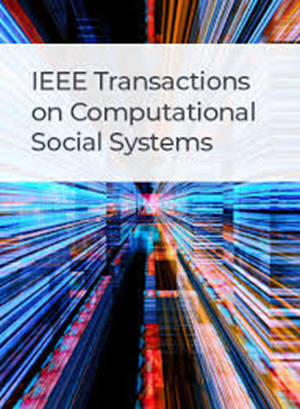基于时间事件共享的动态gcn多任务模型谣言检测
IF 4.5
2区 计算机科学
Q1 COMPUTER SCIENCE, CYBERNETICS
IEEE Transactions on Computational Social Systems
Pub Date : 2024-09-05
DOI:10.1109/TCSS.2024.3443275
引用次数: 0
摘要
谣言检测任务旨在识别在社交媒体上传播的非官方和未经证实的信息。在任何特定的时刻,不同的用户发表自己的观点,关注一些传播事件,他们发布的帖子逐渐形成一个随着发展而扩大的社交网络。随着时间的推移,节点和边形成一个动态图,在不同的时刻呈现不同的状态。然而,现有的研究大多集中在文本内容、社会语境、传播方式等方面,忽视了多方面的因素,没有考虑到社交媒体传播发展中隐含的动态关系。为了分析这些动态特性,本文提出了一种基于动态网络的多任务谣言检测方法,称为基于时序事件共享的动态gcn多任务谣言检测模型(DGCN-TES)。该方法可以有效地捕捉传播事件中关系的动态模式,并随时间变化而变化,从而检测谣言。主要分为三个模块:1)动态图卷积网络(GCN)模块,利用动态图神经网络构建谣言事件在不同时间的传播图,能够更好地捕捉谣言事件随时间变化的动态空间特征;2)内容-长短期记忆(LSTM),它使用LSTM网络作为基准模型,并经过改进,可以更好地捕获时间序列文本特征和多任务共享交互;3)时间事件共享层为共享层,以时间步长为共享的基本单位,实现前两个模块之间动态结构特征与时间文本特征的共享交互。我们在两个真实的谣言检测数据集PHEME和WEIBO上进行了测试,最终结果表明,与其他最佳基线相比,该方法的F1-score分别提高了2.63%和3.91%以上。本文章由计算机程序翻译,如有差异,请以英文原文为准。
DGCN-TES: Dynamic GCN-Based Multitask Model With Temporal Event Sharing for Rumor Detection
The rumor detection task aims to identify unofficial and unconfirmed information that is spreading on social media. At any given moment, different users express their opinions, focusing on some propagation events, and the posts they make gradually form a social network that expands as it grows. Over time, nodes and edges form a dynamic graph that presents different states at different moments. However, most existing research focuses more on the text content, social context, propagation mode, etc., and they ignore the factors from many aspects and do not consider the dynamic relationships implied in the propagation development of social media. To analyze these dynamic properties, this article proposes a dynamic network-based multitask rumor detection method called dynamic GCN-based multitask model with temporal event sharing for rumor detection (DGCN-TES). This method can effectively capture the dynamic patterns of relationships in propagation events and change them over time to detect rumors. It is mainly divided into three modules: 1) dynamic-graph convolutional network (GCN) module, which uses dynamic graph neural network to construct the propagation graph of rumor events at different times, which can better capture the dynamic spatial features that change over time; 2) content-long short-term memory (LSTM), which uses the LSTM network as a benchmark model and has been improved to better capture time-series text features over time and for multitask shared interactions; and 3) temporal event sharing layer is the sharing layer, which uses time step as the basic unit of sharing, and realizes the sharing interaction between dynamic structural features and temporal text features between the first two modules. We tested the method on two real-world rumor detection datasets PHEME and WEIBO, and the final results show that the method improved F1-score by more than 2.63% and 3.91% compared to the other best baselines baseline.
求助全文
通过发布文献求助,成功后即可免费获取论文全文。
去求助
来源期刊

IEEE Transactions on Computational Social Systems
Social Sciences-Social Sciences (miscellaneous)
CiteScore
10.00
自引率
20.00%
发文量
316
期刊介绍:
IEEE Transactions on Computational Social Systems focuses on such topics as modeling, simulation, analysis and understanding of social systems from the quantitative and/or computational perspective. "Systems" include man-man, man-machine and machine-machine organizations and adversarial situations as well as social media structures and their dynamics. More specifically, the proposed transactions publishes articles on modeling the dynamics of social systems, methodologies for incorporating and representing socio-cultural and behavioral aspects in computational modeling, analysis of social system behavior and structure, and paradigms for social systems modeling and simulation. The journal also features articles on social network dynamics, social intelligence and cognition, social systems design and architectures, socio-cultural modeling and representation, and computational behavior modeling, and their applications.
 求助内容:
求助内容: 应助结果提醒方式:
应助结果提醒方式:


